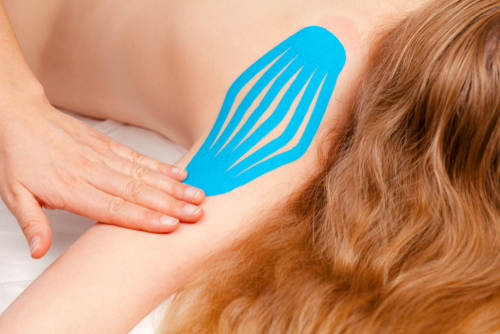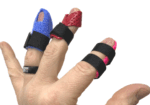All about kinesiology taping for upper extremity injuries and conditions!
Filed under Treatments

All about kinesiology taping!
Elastic is also known as k-tape, Kinesio-tape, and kinesiology taping. Elastic tape is all over the marketplace and is often seen on professional athletes. It can be found in most therapy clinics and is used to treat both orthopedic and neurological conditions. There are limited studies supporting the use of elastic tape, but there is strong anecdotal evidence of its effectiveness.
Elastic tape is another modality for pain management, soft tissue trauma, edema, joint subluxation, and nerve compression.

What is the theory behind elastic taping?
Skin Lifting: The elastic properties behind taping allow it to stretch. When the stretch tape is applied, it helps lift the skin microscopically, allowing for more movement and circulation. When muscles are inflamed and painful, this causes a lack of space; therefore, the lifting properties can be helpful.
Pain Theory or Gate Control Theory: Similar to how we rub our arm when it gets injured. Just rubbing the injury site disrupts the pain signal or the perception of pain, providing some pain relief. So theoretically, applying the tape would close the gate pain.

Provide Muscle Support: Unlike athletic tape, elastic tape is more of a facilitatory tape and aids in supporting the muscle. If taped properly, taping can improve the muscle’s ability to contract. It also still allows for the full range of motion while providing support.
The terminology behind applying k-tape?
Commonly used terms for kinesiology taping include anchor, stretch, and flex. Anchor is the term used to describe the end of the tape, typically the last two inches. This part of the tape should never be stretched or applied with tension.
The stretch is how far you extend the tape. The amount the tape is stretched is usually based on percentages. So if there is no stretch, this is referred to at 0% or paper off. If the tape were to be fully stretched, this would be 100% stretch, if it were between 0-100, it would be 50%.
A few of the basics
Never apply tape to damaged or broken skin. If the individual has sensitive skin, try a small piece of tape on the skin to ensure no skin irritation develops. There are brands of kinesiology tape that are made for sensitive skin.
Make sure the skin is clean and dry before applying the tape. Avoid applying lotions or oils before tape application.
Rond tape edges, so they adhere better.

Once the tape is stuck down, rub it to activate the adhesive, so it adheres better.
Remember not to apply tension at the anchors or ends of the tape.
More To Read
Therapeutic Exercise vs Therapeutic Activity
What is the difference between therapeutic exercise vs therapeutic activity? Therapeutic exercise is billed as 97110 and Therapeutic activity is billed as 97530. Both are CPT codes that are commonly used in occupational and physical therapy billing. These codes are very similar and are often confused. So, when and what do you document for each…
Read MoreAssessing and Improving Grip with the Squegg
Assessing and Improving Grip with the Squegg By: Megan Prather “Grip training is made fun” In hand therapy we are always looking for engaging new interventions to use with patients. The Squegg is a dynamic grip-training tool that can be used with clients both to assess grip strength and to improve strength across sessions. This…
Read MoreOur Favorite Mallet Finger Splints
By: Josh MacDonald Fabricating a custom splint for a mallet finger injury is challenging. Fingers are tiny and they have small tolerances for errors and adjustments with custom splints. Making a splint for a mallet finger injury is probably the hardest type of finger splint for a therapist to make. Treatment recommendations vary, with some…
Read MoreHow to Improve HEP Adherence for Optimal Rehabilitation Outcomes
By Sophia Grimm A lack of adherence to home exercise programs in rehabilitation is a significant problem, with nonadherence estimates as high as 30-65% for general musculoskeletal conditions. This could have potentially detrimental effects on patients’ clinical rehabilitation outcomes as the success of certain medical interventions depends largely on patient adherence to advice and prescribed rehabilitation…
Read MoreSign-up to Get Updates Straight to Your Inbox!
Sign up with us and we will send you regular blog posts on everything hand therapy, notices every time we upload new videos and tutorials, along with handout, protocols, and other useful information.





